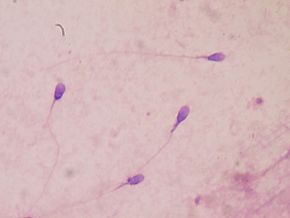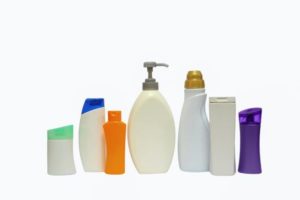 The evidence is building, study by study, that we are all exposed to a mixture of hormone disrupting chemicals (endocrine disruptors) on a daily basis, and that these have serious health effects, including on the developing fetus during pregnancy. Researchers found that early prenatal exposure to a mixture of endocrine disrupting chemicals was associated with lower levels of cognitive functioning (lower IQ scores) at age seven, particularly among boys.
The evidence is building, study by study, that we are all exposed to a mixture of hormone disrupting chemicals (endocrine disruptors) on a daily basis, and that these have serious health effects, including on the developing fetus during pregnancy. Researchers found that early prenatal exposure to a mixture of endocrine disrupting chemicals was associated with lower levels of cognitive functioning (lower IQ scores) at age seven, particularly among boys.
Researchers in New York City and Sweden looked at the impact of 26 endocrine disrupting chemicals during pregnancy on 718 Swedish mother-child pairs. It appeared that the higher the exposure during pregnancy, the more of an effect at age 7. Especially harmful was the BPA replacement chemical BPF - this is because it is chemically related to BPA.
Endocrine disrupting chemicals (EDCs) include bisphenols (BPA and its replacement chemicals, such as BPF - used in products called "BPA free"), phthalates (especially used in vinyl products), parabens, chemicals used in flame retardants and non-stick coatings, and some pesticides (e.g. the commonly used chlorpyrifos).
Especially worrisome is that while scientists typically test chemicals one at a time to determine their safety, in the real world we are all exposed to mixtures of these chemicals in our food, consumer products (including personal care products and cosmetics), and environment. Some of these chemicals can cross the placenta during pregnancy and so have an effect on the developing the fetus, including brain and neurological development. Yes, some of these chemicals are only in the body for a short time, but during critical developmental stages, the effects can be big - even at very low exposures.
Bottom line: If trying to conceive a child or during pregnancy, try to minimize exposure to plastics, pesticides, flame retardants, non-stick cookware, stain-proofing (in fabric and rugs), fragrances and scented products (including air fresheners and dryer sheets), and food stored in cans and plastic containers. Avoid triclosan, anti-odor, antibacterial, anti-germ products and clothing. Avoid parabens (in lotions, etc). Read labels. Glass and stainless steel is perfectly fine. Use unscented or fragrance free products as much as possible.
From Medical Xpress: Chemicals in consumer products during early pregnancy related to lower IQ ...continue reading "Pregnancy, Endocrine Disrupting Chemicals, and Lower IQ"

 Did you know that many tea bags contain plastic or are made totally from plastic? And that tiny pieces of plastic (microplastics) from these teabags are released into the hot water when brewing tea?
Did you know that many tea bags contain plastic or are made totally from plastic? And that tiny pieces of plastic (microplastics) from these teabags are released into the hot water when brewing tea?  More bad news about the toxic class of chemicals called PFAS chemicals, which are used in a wide variety of consumer products, such as Teflon non-stick cookware and Scotchgard. The problem is that the chemicals don't stay in the products, but leach out (migrate out) and spread further - even into us. Unfortunately these chemicals persist in the environment. Earlier studies had already detected PFAS (per- and polyfluoroalkyl substances) chemicals in water, soil, some foods, and in the bodies of almost all Americans. Now some recent research studies and the efforts of investigative journalists have uncovered more disturbing findings about the spread of these chemicals in the environment, in foods, and us.
More bad news about the toxic class of chemicals called PFAS chemicals, which are used in a wide variety of consumer products, such as Teflon non-stick cookware and Scotchgard. The problem is that the chemicals don't stay in the products, but leach out (migrate out) and spread further - even into us. Unfortunately these chemicals persist in the environment. Earlier studies had already detected PFAS (per- and polyfluoroalkyl substances) chemicals in water, soil, some foods, and in the bodies of almost all Americans. Now some recent research studies and the efforts of investigative journalists have uncovered more disturbing findings about the spread of these chemicals in the environment, in foods, and us. Two years ago
Two years ago  A recent study found that within hours of applying
A recent study found that within hours of applying  Many of us have concerns over the fact that people are constantly exposed to endocrine disruptors (chemicals that disrupt hormonal systems) in many common household and personal products. Even the vinyl flooring found in many homes contains phthalates, which are endocrine disrupting chemicals.
Many of us have concerns over the fact that people are constantly exposed to endocrine disruptors (chemicals that disrupt hormonal systems) in many common household and personal products. Even the vinyl flooring found in many homes contains phthalates, which are endocrine disrupting chemicals. Many health professionals have warned for years that the antibacterial triclosan should be avoided. Triclosan is found in a large variety of personal and consumer products labeled "antibacterial" or "antimicrobial". Now a
Many health professionals have warned for years that the antibacterial triclosan should be avoided. Triclosan is found in a large variety of personal and consumer products labeled "antibacterial" or "antimicrobial". Now a